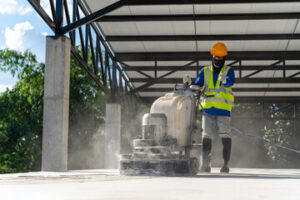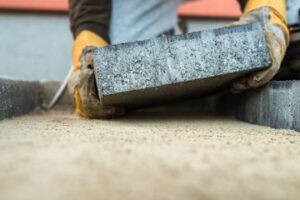Concrete Resurfacing Huntsville TX is a great way to update your concrete floors without the cost of replacement. This restoration technique revives worn or damaged concrete surfaces with a decorative overlay.

Before applying a concrete resurfacer, the existing surface needs to be properly cleaned. Any cracks and chips should be repaired using a patching product. The surface must be free of failing paints and sealers, which will prevent the resurfacer from bonding.
Concrete is one of the most common materials used in construction, but it can become damaged over time. Cracks, divots, and discoloration can cause safety hazards and reduce the aesthetic value of the surface. Concrete resurfacing is a cost-effective way to repair these problems and give the surface a new look. This process is also much less disruptive than traditional concrete replacement.
Choosing between resurfacing and replacement is a decision that should be made after carefully evaluating the condition of the concrete and considering your budget and long-term goals. Resurfacing can be more cost-effective than replacing the concrete, but it may require more frequent maintenance and repair. Resurfacing also provides limited decorative options, while overlays offer a wider range of designs and textures.
Resurfacing is ideal for surfaces with minor cosmetic issues and surface damage, but it’s not a good choice for structural problems. For example, heaving and settled concrete are not candidates for resurfacing, but these issues can be addressed by concrete leveling.
The cost of concrete resurfacing depends on the size of the project and material type. It’s important to consult with a professional contractor for accurate estimates. The price of the resurfacing material will also affect the total cost. Using high-quality materials and professional installation will ensure a quality finish that lasts for as long as possible.
It’s also important to consider the amount of labor required for the project. Resurfacing is typically cheaper than replacement, but it can still be more expensive than other refinishing options. DIYers can save on labor costs by completing some of the preparation work themselves, such as power washing or patching any areas that need attention.
Another factor to consider is the impact on traffic and the environment. Heavily trafficked areas or those that need to support a significant load may require a full replacement to ensure the concrete can withstand the demands placed on it. Likewise, replacing the concrete may be necessary to comply with updated building codes or accessibility standards.
Durability
Concrete resurfacing is a great option for homeowners who want to improve the appearance of their existing concrete without the cost and hassle of removing and replacing it. This method of repairing damaged concrete can last 10 years or more when properly installed and cared for. It can also be customized with a variety of textures, patterns, and colors to suit any decor or landscaping theme. However, it is important to understand the limitations of this method. It is not suitable for all situations, including severe structural damage.
Before resurfacing, the concrete should be thoroughly inspected to identify any significant damage or problems. It is not possible to resurface concrete that is severely cracked, damaged by freeze-thaw damage, or shifting. Resurfacing can mask these issues, but the underlying damage should be addressed before considering resurfacing.
The durability of concrete resurfacing depends on the quality of the materials used and the installation process. It is essential to choose high-quality resurfacing products and have the work professionally done. Poor quality or installation will result in early failure. Concrete resurfacing also requires regular maintenance and cleaning to prevent deterioration and staining.
Unlike new concrete, resurfaced concrete is not as dense and durable. It is vulnerable to stains, water and oil penetration, and environmental factors like UV rays. It is also not as resistant to abrasion and traffic damage.
Resurfacing is not a long-term solution to structural problems, so it is best suited for cosmetic improvements. It is not a good idea to resurface concrete that is subjected to frequent traffic, heavy loads, or chemicals. It is also not recommended for outdoor use in harsh environments.
The best way to maintain the durability of a resurfaced concrete surface is to conduct periodic inspections and address any damage or deterioration promptly. It is also a good idea to avoid using deicing chemicals on the concrete, as they can cause damage and increase deterioration. Moreover, it is a good idea to keep the resurfaced concrete damp for 24 hours after application to promote a strong bond and to prevent shrinkage cracks.
Appearance
Resurfacing a concrete surface can be an excellent option for improving the look of your home without the cost and timeframe associated with a complete replacement. Depending on the finish you choose, resurfacing can also reduce the amount of maintenance required. However, it is important to note that the durability and life span of your new concrete will be largely dependent on how well you maintain it.
Concrete Resurfacing uses a cementitious overlay mixture that combines basic Portland cement with fine sands and polymer modifiers to create adhesion. This material is applied in thin layers over existing concrete surfaces, creating a brand-new surface that is strong and durable. It can be used on sidewalks, patios, driveways and other outdoor surfaces. The resurfacing material can be colored and textured to achieve the desired appearance.
A common concern for homeowners is the longevity of a resurfaced concrete surface. However, this can be greatly improved by ensuring that proper preparation and curing practices are followed. This will help to ensure that the resurfacing material adheres properly and is not exposed to moisture or temperature fluctuations that could cause damage.
In addition, it is essential to use a sealant that is compatible with the resurfacing material and the existing concrete. Failure to do so can result in the new surface becoming damaged or deteriorating quickly.
Choosing a concrete resurfacing product that is best suited for your specific needs is also vital. Resurfacing products are available in a variety of finishes, so it is important to consider the intended usage and durability requirements of your concrete surface before making your decision.
If you want to make a dramatic change to the look of your concrete, an overlay may be a better choice. These products offer a limitless number of design possibilities. They can be stamped, stenciled, colored and textured to create a unique look that is truly your own.
In addition to a wide range of decorative options, overlays can be used to repair cracks and other imperfections in existing concrete. They are available in a wide range of thicknesses, and can be poured or troweled onto the existing concrete.
Maintenance
Concrete resurfacing is an affordable and durable option for improving the look of your driveway, sidewalk, patio, pool deck or other hardscape. It will help to improve curb appeal and increase the value of your property. However, before resurfacing your concrete, you must ensure that the surface is structurally sound and free of cracks larger than 1/4-inch wide. This will allow the resurfacing material to bond properly with the existing concrete. Also, the surface should be clean and free of oil and grease to allow the resurfacer to adhere effectively. Finally, it is important to address any expansion or control joints before applying the resurfacer.
If you do decide to resurface your concrete, it is best to hire a professional with the necessary skills and experience. A pro will be able to inspect your concrete and determine whether it is suitable for resurfacing. They will also be able to provide you with an estimate of the cost of the job. It is a good idea to get quotes from several different contractors to compare prices and quality.
Resurfacing is a quick and convenient solution for restoring damaged concrete. It saves the time and expense of tearing up the existing concrete and pouring a new slab. It is a good choice for surfaces that are used frequently and subject to heavy traffic, as well as for areas where the concrete is exposed to UV rays.
In addition, resurfacing is ideal for concrete that has minor cosmetic problems, such as pitting and spalling. It is not suitable for concrete with significant structural problems, such as heaving or settlement. These problems may require more advanced repair techniques, such as concrete leveling.
Resurfacing is an excellent way to restore your concrete and protect it from future damage. Regular cleaning, sealing and timely repair will prolong the lifespan of your resurfaced concrete. You should also avoid excessive use of abrasive equipment and harsh chemicals on the surface to prevent premature wear. A resurfacing contractor will be able to advise you on the best maintenance practices for your concrete.
